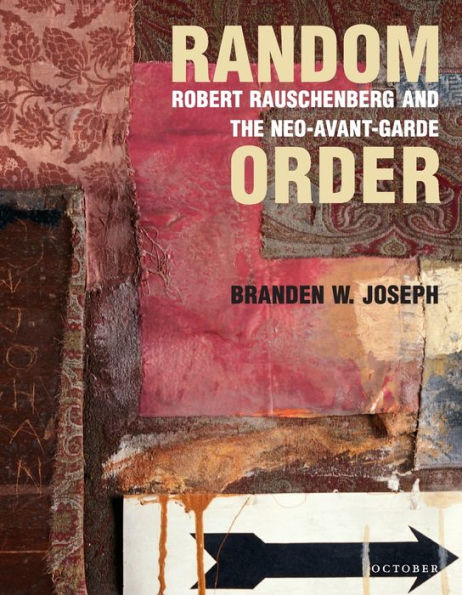
Random Order: Robert Rauschenberg and the Neo-Avant-Garde
432
Random Order: Robert Rauschenberg and the Neo-Avant-Garde
432Paperback(New Edition)
-
PICK UP IN STORECheck Availability at Nearby Stores
Available within 2 business hours
Related collections and offers
Overview
Robert Rauschenberg is one of the most important visual artists of the second half of the twentieth century. In Random Order, Branden Joseph examines Rauschenberg's work in the context of the American neo-avant-garde. One of the foundations of his study is Rauschenberg's professional relationship with experimental composer John Cage. From the moment of their encounter at Black Mountain College in 1952, Joseph argues, Rauschenberg and Cage initiated a new avant-garde project, one that approached the idea of difference not in terms of negation but as a positive force. Claiming that Rauschenberg's work cannot be understood solely from the standpoint of the Frankfurt School—whose theories have dominated discussions of avant-garde and neo-avant-garde aesthetics—Joseph turns to the theoretical positions of Gilles Deleuze and Jacques Derrida. Rauschenberg's neo-avant-garde was not a simple repetition of earlier avant-garde movements, Joseph shows, but a series of practices that opposed the rise of postwar spectacle, commodification, and mass conformity.
Beginning with the White Paintings, Joseph examines Rauschenberg's artistic development from 1951 to 1971. He looks at the black paintings, Red Paintings, Elemental Paintings and Elemental Sculptures, Combines and Combine paintings, transfer drawings and silkscreens, performances, and explorations in art and technology. Joseph's study not only offers new interpretations of Rauschenberg's work, but also deepens our understanding of the entire neo-avant-garde project.

Product Details
| ISBN-13: | 9780262600712 |
|---|---|
| Publisher: | MIT Press |
| Publication date: | 02/23/2007 |
| Series: | October Books |
| Edition description: | New Edition |
| Pages: | 432 |
| Product dimensions: | 7.00(w) x 9.00(h) x 0.75(d) |
| Age Range: | 18 Years |
About the Author
Table of Contents
Acknowledgments xi
Introduction: The Art of Assemblage 1
White on White 25
Pedestrian Colors 73
Mole Archaeology 121
Split Screens 173
Moving Images 209
Conclusion 281
Notes 287
Bibliography 379
Index 409
What People are Saying About This
Branden Joseph's strikingly original study of Robert Rauschenberg will also be influential as a remarkable cultural history of the intersection of art, media, and technology in the 1960s. Among the book's great merits are its stunning de-familiarization of a well known artist's work and its impressive reconsideration of the political stakes in the aesthetic practices of the period.
Set against today's fast-paced, cut-and-paste art spectacles, Rauschenberg's collages, combines, art and technology experiments, and multimedia performances may seem old hat, a bunch of outmoded forms and tamed ideas. But through impeccable archival research and a detailed rereading of Rauschenberg's early works and the context of their emergence and immediate reception, Branden Joseph revivifies the radical spirit of the old. Random Order's recasting of the not yet canonical artist as a Deleuzian deconstructionist and an inheritor of Artaud's theater of cruelty is bound to be controversial among not only Rauschenberg scholars but also historians of the postwar neo-avant-garde. All the better to encourage a reimagining of the present.
Scrupulously documented and brilliantly argued, Random Order is the most extensive and probing understanding we have of the aesthetic, historical, and political stakes of Rauschenberg's neo-avant-garde artistic project. Like Rauschenberg's 'mole archaeologist,' Joseph unearths the network of artists and theorists that countersigned the artist's desire to enact, in each of his works, not only what it means to encounter a work of art but also how to use it as a weapon to transform our conception of art and the relations in which we live. In the process, he gives us a stunning analysis of the artistic process itself—a process that, as he so beautifully demonstrates, always carries us—with random but unrelenting force—beyond ourselves.
Reynolds has revitalized not only an important and little-researched moment in Smithson's career, but also—and perhaps more significantly—a crucial event in the history of art practice in the U.S. and beyond.
Scrupulously documented and brilliantly argued, Random Order is the most extensive and probing understanding we have of the aesthetic, historical, and political stakes of Rauschenberg's neo-avant-garde artistic project. Like Rauschenberg's 'mole archaeologist,' Joseph unearths the network of artists and theorists that countersigned the artist's desire to enact, in each of his works, not only what it means to encounter a work of art but also how to use it as a weapon to transform our conception of art and the relations in which we live. In the process, he gives us a stunning analysis of the artistic process itself—a process that, as he so beautifully demonstrates, always carries us—with random but unrelenting force—beyond ourselves.
—Eduardo Cadava, Princeton University, author of Words of Light: Theses on the Photography of History
Branden Joseph's strikingly original study of Robert Rauschenberg will also be influential as a remarkable cultural history of the intersection of art, media, and technology in the 1960s. Among the book's great merits are its stunning de-familiarization of a well known artist's work and its impressive reconsideration of the political stakes in the aesthetic practices of the period.
—Jonathan Crary, Columbia UniversitySet against today's fast-paced, cut-and-paste art spectacles, Rauschenberg's collages, combines, art and technology experiments, and multimedia performances may seem old hat, a bunch of outmoded forms and tamed ideas. But through impeccable archival research and a detailed rereading of Rauschenberg's early works and the context of their emergence and immediate reception, Branden Joseph revivifies the radical spirit of the old. Random Order's recasting of the not yet canonical artist as a Deleuzian deconstructionist and an inheritor of Artaud's theater of cruelty is bound to be controversial among not only Rauschenberg scholars but also historians of the postwar neo-avant-garde. All the better to encourage a reimagining of the present.
—Miwon Kwon, Department of Art History, University of California, Los Angeles